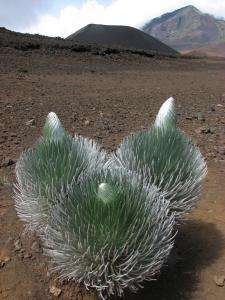Researchers find shifting climate patterns are threatening native silverswords

A new study published in Climate Change Responses by UH Mānoa researchers shows how shifting atmospheric circulation patterns that may be caused by climate change are threatening populations of the iconic silversword on Haleakalā, Maui. The native plant is found nowhere else in the world.
Dr. Paul Krushelnycky of the Department of Plant and Environmental Protection Sciences and his co-authors researched the effects of changes in temperature, precipitation and solar radiation on populations of silverswords, using 80 years of data records. The team found that Haleakalā silversword numbers have declined about 60% since 1990 and that this decline coincides with lower rainfall in the area, which may be due in part to increased occurrences of trade wind inversion. "This is important because it shows the potential complexity of changing climate conditions and responses of species to these changes," said Krushelnycky.
The trade wind inversion (TWI) forms when rising air is impeded by dry descending air originating near the equator. This caps the vertical formation of clouds, resulting in the familiar cloud layer that forms on the upper slopes of Hawaii's higher mountains. The TWI occurs most days, and on Haleakalā it usually holds the cloud layer just below where the silverswords reside, typically keeping them in sunny and dry conditions.

When this TWI pattern is disrupted, clouds, fog and rainfall are able reach the higher altitudes, bringing water to the plants and providing shade, which slows evaporation and allows the plants to retain more of that moisture. Breaks in the TWI therefore appear necessary for the silverswords. However, scientists have noted that this disruption of the TWI has now been happening less often, creating drier conditions above the inversion layer.
This moisture reduction has been especially damaging to the silverswords in the lower portion of their range, where the habitat is wetter, and unfortunately this pattern may persist. Climate projections anticipate that the TWI may occur more consistently, with fewer disruptions, and may even start occurring at lower elevations. Some projections also predict that rainfall will lessen on the upper reaches of Haleakalā, while others predict wetter future conditions.
Krushelycky emphasized that there may be some hope for the threatened silversword: "The long-term data set shows that the silversword population can rebound and grow quite quickly, as it did before when it was protected from threats." The population had undergone a large decline in the early decades of the twentieth century due to unrestricted grazing of goats and cattle, along with people disrupting and gathering the plants. But committed protection and management by the Haleakalā National Park allowed the plants to return to their former glory…until the latest threat from climate change. "Rainfall was higher then," Krushelnycky said of the previous rebound. "This implies that the future health of this species will probably depend on a return to wetter conditions."
The full article, "Change in trade wind inversion frequency implicated in the decline of an alpine plant," may be found here. This work was supported by the Department of Interior Pacific Islands Climate Science Center, which is managed by the USGS National Climate Change and Wildlife Science Center. The center is one of eight that provides scientific information to help natural resource managers respond effectively to climate change.
This study was also supported by the the Pacific Islands Climate Change Cooperative, (PICCC), a conservation alliance assisting those who manage native species, island ecosystems, and key cultural resources in adapting their management to climate change. The PICCC is one of 22 Landscape Conservation Cooperatives with the vision of creating landscapes capable of sustaining natural and cultural resources for current and future generations.
More information: Paul D. Krushelnycky et al. Change in trade wind inversion frequency implicated in the decline of an alpine plant, Climate Change Responses (2016). DOI: 10.1186/s40665-016-0015-2
Provided by University of Hawaii at Manoa



















